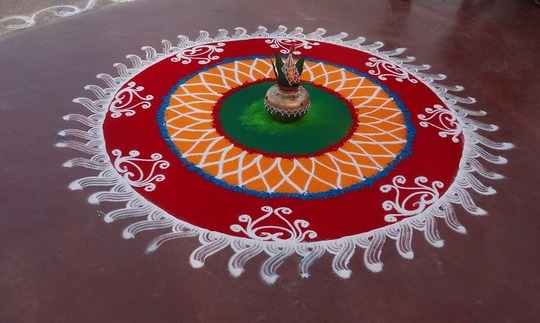
Have you ever walked through a vibrant Indian neighborhood during festivals and marveled at the intricate and colorful designs adorning the ground? These captivating patterns, known as Rangoli, hold deep significance and play an essential role in Indian culture. In this article, we will delve into the fascinating world of Rangoli, exploring its meaning, historical roots, and the cultural importance it holds. So, let’s embark on this colorful journey together!
Rangoli is an ancient art form that has been passed down through generations in India. The word “Rangoli” is derived from the Sanskrit words “rang” (color) and “aavalli” (row), meaning a row of colors. Historically, Rangoli was created using rice flour, colored sand, or flower petals. Over time, the art form has evolved, and today, people use a variety of materials like colored powders, flower petals, and even rice to create these stunning designs.
Also Read – The Impact of Feng Shui on Your Health and Well-being: Harmonizing Your Living Spaces for Vitality
Rangoli is prominently seen during various Indian festivals and celebrations. Diwali, the Festival of Lights, is one of the most significant occasions where Rangoli takes center stage. People create intricate designs at their doorsteps to welcome Goddess Lakshmi, the goddess of wealth and prosperity. It is believed that these vibrant patterns invite positive energy and good luck into homes.
One of the most remarkable aspects of Rangoli is that it is not limited to a particular region or community. Different regions of India have their unique styles and patterns, showcasing the rich cultural diversity of the country. From the mesmerizing geometric patterns of Rajasthan to the floral designs of Kerala, each Rangoli is a reflection of the local traditions and customs.
Rangoli is not just about creating visually appealing designs; it is also steeped in symbolism. The colors used in Rangoli hold significant meaning. Red signifies passion and love, yellow represents happiness and vitality, blue symbolizes the divine and the vastness of the sky, and green stands for fertility and harmony with nature. By using these colors, Rangoli becomes a medium to express various emotions and sentiments.
Also Read – Discover Your Personality Through Hand Shape: Unraveling the Science
The process of creating Rangoli is meditative and therapeutic. As the designs unfold, one gets engrossed in the intricate details, allowing the mind to attain a state of calm and focus. It is no wonder that Rangoli is often considered a form of meditation in motion, connecting the creator with their inner self and the world around them.
Rangoli holds immense cultural significance, not only in festive celebrations but also as a means of bonding within families. It is a tradition that is passed down from mothers to daughters, from grandmothers to grandchildren, preserving the art form and strengthening family ties. The joy of creating Rangoli together fosters a sense of togetherness and unity.

While Rangoli remains deeply rooted in tradition, it has also adapted to modern times. Today, you can find kolam competitions, where participants showcase their artistic skills and creativity. These competitions not only keep the tradition alive but also encourage innovation and contemporary expressions of Rangoli.
Also Read – Astrology and Color Therapy: Using Hues to Enhance Zodiac Traits
Beyond its cultural and artistic significance, Rangoli spreads joy and happiness. When people come together to create Rangoli during festivals or events, it fosters a sense of community and celebration. Passersby are often left in awe of the intricate designs, and the vibrant colors uplift their spirits, making the surroundings more cheerful and positive.
Rangoli is more than just a form of artistic expression; it is a representation of India’s diverse culture, heritage, and traditions. From its ancient origins to its relevance in contemporary times, Rangoli has retained its charm and significance. So the next time you encounter a beautiful Rangoli design, take a moment to appreciate not only its visual beauty but also the rich cultural tapestry it represents.
For interesting astrology videos, follow us on Instagram
2,000
2,000




Choose your and your partner's zodiac sign to check compatibility